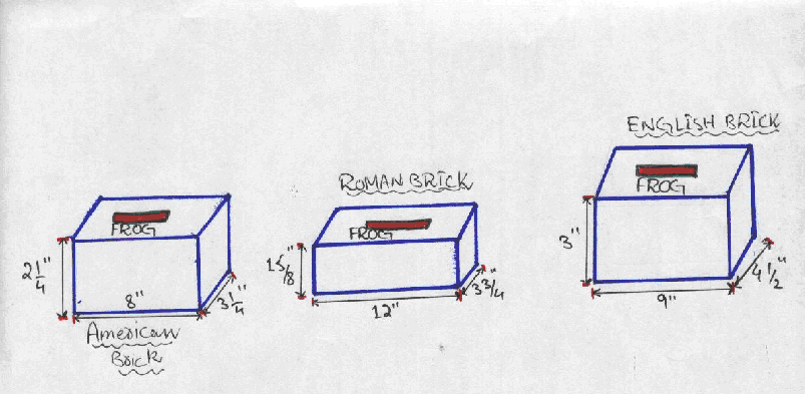Presentation on brick and stone masonry
When bricks are laid in mortar in a proper systematic manner, they form a homogeneous mass, which can withstand forces without disintegration. This mass of the structure, so made by the use of bricks is called "Brick Masonry" or simply "Brick work".
Bricks are of uniform size and shape, light in weight, durable, fire resistant, have high resale value, low maintenance cost and are easily available in plain areas.
Brick Masonry is commonly used for construction of ordinary as well as important buildings in plain areas now-a-days.

I have attached, detailed presentation on all aspects of Brick and Stone Masonry, it includes following topic in details;
Some important terms used in brick masonry
Brick, frog, Positions of Bricks, course, stretcher, header, quoin, quoin brick, quoin header, quoin stretcher, brick bats, Queen closer, King closer, beveled closer, bull nose brick, squint bricks, jamb, reveals, sill, Mortar.

Types of bonds in masonry
English bond
Flemish bond
Comparison of English Bond and Flemish bond
Types of flemish bonds
Double Flemish Bond
Single Flemish bond or Cross bond
Heading bond
Stretching bond
Garden Wall Bond
Types of garden wall bonds
English Garden Wall Bond
Flemish Garden Wall Bond
Sussex or Scotch Bond
Raking bond
Herring Bone Bond
Diagonal bond
Hoop Iron Bond
Monk bond
Rhom bond
All types of masonry bonds are explained along with sketched in attached presentation.
STONE MASONRY
Main types of stone masonry
Rubble Masonry
Ashlar Masonry
Types of rubble masonry
Random Rubble masonry
(i) Uncoursed random rubble Masonry
(ii) Built to courses random rubble Masonry
Squared Rubble
(i) Uncoursed squared rubble Masonry
(ii) Built to courses squared rubble Masonry
(iii) Regular coursed squared rubble Masonry
Dry rubble masonry
Types of ashlar masonry
Ashler fine / coursed ashlar masonry
Random Coursed Ashlar Masonry
Rough tooled ashler masonry
Quarry Faced Ashlar Masonry
Chamfered Ashlar Masonry
Ashlar Facing
Comparison Between Brick Masonry And Stone Masonry
Factors to be considered while site selection
General precautions in selection of site
Orientation of buildings
Factors affecting orientation of buildings
Orientation in different regions
Pre-construction Site Works
Site Survey
Profile Boards
Removal Of Top Soil
Site Drainage
Excavation
Safety In Excavation
Timbering of Trenches
Timbering of trenches in Hard Soil (With a central strut to each pair of Poling Boards)
Timbering of trenches in Hard Soil (With two struts to each pair of Poling Boards)
Timbering of trenches in Moderately Hard Soil (With Walings strutted at alternate Poling Boards )
Timbering of trenches in Moderately Hard Soil (With a central Waling strutted at every fourth Poling Board)
Timbering of trenches in Moderately Hard Soil (With a simple Waling strutted at 2 m interval)
Timbering of trenches in Loose Soil (With horizontal sheeting)
Timbering of trenches in Loose Soil (With vertical sheeting)
Timbering of trenches in very loose soil (With Runners)
Dampness
Sources of dampness
Ill effects of dampness
Causes of dampness
Prevention of Dampness
Download the completely detailed presentation on Bricks and Stone Masonry Works from below attachment.
When bricks are laid in mortar in a proper systematic manner, they form a homogeneous mass, which can withstand forces without disintegration. This mass of the structure, so made by the use of bricks is called "Brick Masonry" or simply "Brick work".
Bricks are of uniform size and shape, light in weight, durable, fire resistant, have high resale value, low maintenance cost and are easily available in plain areas.
Brick Masonry is commonly used for construction of ordinary as well as important buildings in plain areas now-a-days.

I have attached, detailed presentation on all aspects of Brick and Stone Masonry, it includes following topic in details;
Some important terms used in brick masonry
Brick, frog, Positions of Bricks, course, stretcher, header, quoin, quoin brick, quoin header, quoin stretcher, brick bats, Queen closer, King closer, beveled closer, bull nose brick, squint bricks, jamb, reveals, sill, Mortar.

Types of bonds in masonry
English bond
Flemish bond
Comparison of English Bond and Flemish bond
Types of flemish bonds
Double Flemish Bond
Single Flemish bond or Cross bond
Heading bond
Stretching bond
Garden Wall Bond
Types of garden wall bonds
English Garden Wall Bond
Flemish Garden Wall Bond
Sussex or Scotch Bond
Raking bond
Herring Bone Bond
Diagonal bond
Hoop Iron Bond
Monk bond
Rhom bond
All types of masonry bonds are explained along with sketched in attached presentation.
STONE MASONRY
Main types of stone masonry
Rubble Masonry
Ashlar Masonry
Types of rubble masonry
Random Rubble masonry
(i) Uncoursed random rubble Masonry
(ii) Built to courses random rubble Masonry
Squared Rubble
(i) Uncoursed squared rubble Masonry
(ii) Built to courses squared rubble Masonry
(iii) Regular coursed squared rubble Masonry
Dry rubble masonry
Types of ashlar masonry
Ashler fine / coursed ashlar masonry
Random Coursed Ashlar Masonry
Rough tooled ashler masonry
Quarry Faced Ashlar Masonry
Chamfered Ashlar Masonry
Ashlar Facing
Comparison Between Brick Masonry And Stone Masonry
Factors to be considered while site selection
General precautions in selection of site
Orientation of buildings
Factors affecting orientation of buildings
Orientation in different regions
Pre-construction Site Works
Site Survey
Profile Boards
Removal Of Top Soil
Site Drainage
Excavation
Safety In Excavation
Timbering of Trenches
Timbering of trenches in Hard Soil (With a central strut to each pair of Poling Boards)
Timbering of trenches in Hard Soil (With two struts to each pair of Poling Boards)
Timbering of trenches in Moderately Hard Soil (With Walings strutted at alternate Poling Boards )
Timbering of trenches in Moderately Hard Soil (With a central Waling strutted at every fourth Poling Board)
Timbering of trenches in Moderately Hard Soil (With a simple Waling strutted at 2 m interval)
Timbering of trenches in Loose Soil (With horizontal sheeting)
Timbering of trenches in Loose Soil (With vertical sheeting)
Timbering of trenches in very loose soil (With Runners)
Dampness
Sources of dampness
Ill effects of dampness
Causes of dampness
Prevention of Dampness
Download the completely detailed presentation on Bricks and Stone Masonry Works from below attachment.
